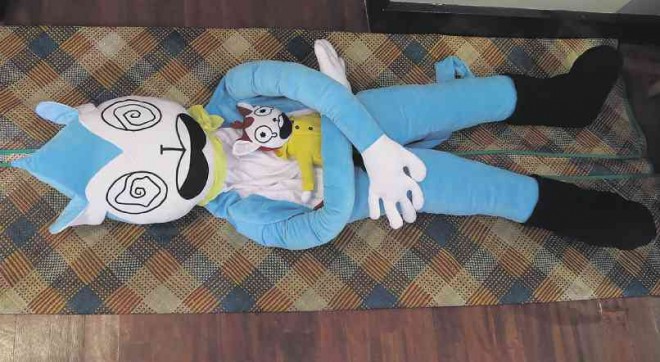
DISASTER DOLLS Innovators in Japan introduced these stuffed toys which they use at play time to teach students about disaster response drills. EV ESPIRITU
BOY SCOUTS have the best ideas. Their motto, “Be prepared,” is as relevant in a world confronting unprecedented extreme weather, as it was in the early 1900s when preparedness was first articulated by the world scouting movement.
But preparation requires a huge amount of learning and common sense.
When he opened a University of the Philippines Baguio forum on climate change resilience early this year, UP President Alfredo Pascual said he organized a multidisciplinary team of social planners, scientists, engineers and architects to help areas in the Visayas devastated by Supertyphoon “Yolanda” (international name: Haiyan), including the UP campuses there.
Pascual said the times required a combination of experts to collaborate and design disaster-resilient campuses for UP, noting that Filipinos have the ingenuity to plan for disasters, of which the country is “intimately familiar.”
Collaboration is also the spirit of a new exhibit at the Maryknoll Ecological Sanctuary in Baguio City. It is mounted by a Japanese initiative, Design and Creative Center Kobe (or Kiito), to devise and share the community know-how of Asian countries which face climate change-triggered calamities on a regular basis.
The Earth Manual Project exhibit compiles 23 innovations which worked in Thailand,
Indonesia, the Philippines and Japan, a country known for its drive to beat disasters.
Since its first exhibition in 2013 in Kobe, Japan, Kiito has been urging countries prone to natural calamities to be “exceptionally disaster-prepared.”
The Kobe exhibit was staged two years after northeastern Japan was rocked by a
9-magnitude earthquake and was swept by a destructive tsunami.
The website, Livescience (www.livescience.com), in a May 7 post, said “Japan’s one-two punch proved especially devastating for the earthquake-savvy country because few scientists had predicted [Japan] would experience such a large earthquake and tsunami.”
The Earth Manual Project is in Baguio, a city that suffered and bounced back from the devastation caused 25 years ago by a 7.7-magnitude earthquake that rocked Luzon.
Embrace disaster preparedness
Erlyn Alcantara, curator of the Sanctuary Gallery that is featuring the Earth Manual Project until Aug. 30, hopes that the project gets the same creative reflection many Asians undertook in embracing disaster preparedness and employing practical ideas, especially in Baguio.
“Science teachers in Baguio can encourage their students to conceptualize a project that their families or barangay can use during times of typhoon, earthquake or flood,” she says.
“Universities with food processing classes can produce relief food packs that are healthy using dried vegetables, camote and potatoes so we can stop distributing noodles with high salt and high MSG content,” she adds.
The Earth Manual offers ideas that people often take for granted.
For example, in Thailand, floods have been inflicting heavy damage so communities there have thought of ways to use household items such as flood survival gear, upon the initiative of Design for Disasters, a group of Thai artists, architects and academics.
Floating toilets, paper houses
Their exhibit features flotation devices built from plastic bottles and fishing nets, and washbowls that serve as lifeboats.
A design competition mounted by the Thailand Creative and Design Center for survivors of a 2011 flood elicited ideas like a waterless floating toilet.
An exhibit set promotes the use of floating desks and chairs for schools often submerged by flood waters which could be an appropriate technology for flood-prone communities in the Philippines.
One of the Japanese exhibits features the color-coded “Ability Bibs,” which volunteer workers and rescuers wear to identify themselves properly to disaster survivors.
The idea was executed by “Issue+Design,” formed by Yusuke Kakei, an engineering graduate, who realized that calamity survivors need to connect properly with the people who help them.
Another Japanese contribution addresses a neglected problem concerning evacuation sites: The absence of privacy.
Architect Shigeru Ban designed partitions or cubicles made of paper for survivors of the 2011 earthquake (also known as the Great East Japan Earthquake).
Alcantara says paper tubes can be gathered from tarp printers and textile shops, even have them hauled from Metro Manila by the truckloads and formed into paper homes for evacuees.
“There are tons of these in Manila which can be given away to anyone willing to pay the trucking cost to Baguio. The paper can be waterproofed with varnish and put together by drilling joint holes,” she says.
The Jishin Itsumo Project features handkerchiefs printed with disaster prevention reminders, “which can be adopted to local conditions, conceptualized and produced—and like in Japan—sponsored by companies,”
Alcantara says.
If people start arguing that these ideas are too out-of-the-box, the Earth Manual Project features architect Toshiaki Hisatomi’s “Fast Box,” which features containers that also serve as tables, chairs or even partitions when put together.
“In the evacuation center, evacuees kept their everyday items on the floor. Boxes were found to be in high demand because they could be used to store such daily items,” according to the Fast Box chapter of the Earth Manual. The chapter describes the box as “the most flexible piece of furniture in the world.”